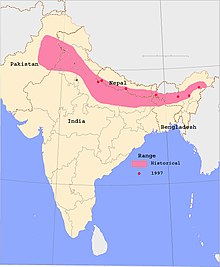Indian rhinoceros
| Indian rhinoceros | |
|---|---|
 |
|
| An Indian rhinoceros in the Kaziranga National Park. | |
| Scientific classification | |
| Kingdom: | Animalia |
| Phylum: | Chordata |
| Class: | Mammalia |
| Order: | Perissodactyla |
| Family: | Rhinocerotidae |
| Genus: | Rhinoceros |
| Species: | R. unicornis |
| Binomial name | |
|
Rhinoceros unicornis Linnaeus, 1758 |
|
 |
|
| Indian rhinoceros range | |
| The Rhinoceros | |
|---|---|
 |
|
| Artist | Albrecht Dürer |
| Year | 1515 |
| Type | woodcut |
| Dimensions | 24.8 cm × 31.7 cm (9.8 in × 12.5 in) |
The Indian rhinoceros (Rhinoceros unicornis), also called the greater one-horned rhinoceros and great Indian rhinoceros, is a rhinoceros native to the Indian subcontinent. It is listed as Vulnerable on the IUCN Red List, as populations are fragmented and restricted to less than 20,000 km2 (7,700 sq mi). Moreover, the extent and quality of the rhino's most important habitat, alluvial grassland and riverine forest, is considered to be in decline due to human and livestock encroachment.
The Indian rhinoceros once ranged throughout the entire stretch of the Indo-Gangetic Plain, but excessive hunting and agricultural development reduced their range drastically to 11 sites in northern India and southern Nepal. In the early 1990s, between 1,870 to 1,895 rhinos were estimated to have been alive. In 2015, a total of 3,555 Indian rhinoceros are estimated to live in the wild.
The modern scientific designation Rhinoceros unicornis is adopted from the Greek: ρινό- ("rhino-" — nose) and -κερος ("-keros" — horn of an animal) and Latin: "uni-" meaning single and "-cornis" meaning horn.
Rhinoceros unicornis was the type species for the rhinoceros family, first described by Carl Linnaeus in 1758.
The one-horned rhinoceros is monotypic. Several specimens were described since the end of the 18th century under different scientific names, which are all considered synonyms of Rhinoceros unicornis today:
Ancestral rhinoceroses first diverged from other perissodactyls in the Early Eocene. Mitochondrial DNA comparison suggests the ancestors of modern rhinos split from the ancestors of Equidae around 50 million years ago. The extant family, the Rhinocerotidae, first appeared in the Late Eocene in Eurasia, and the ancestors of the extant rhino species dispersed from Asia beginning in the Miocene.
...
Wikipedia

